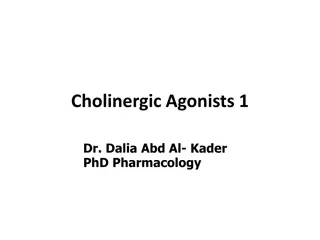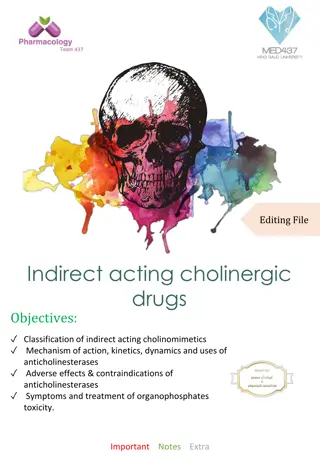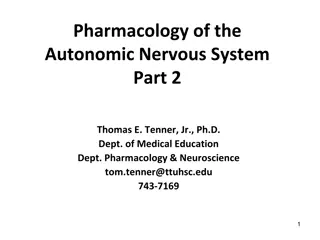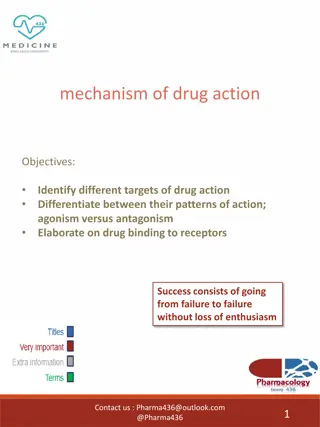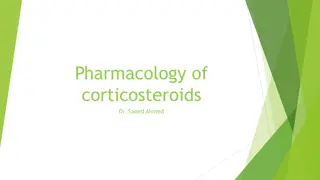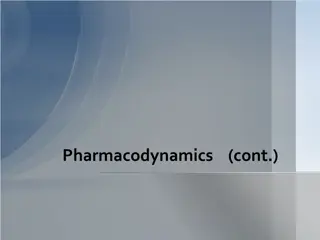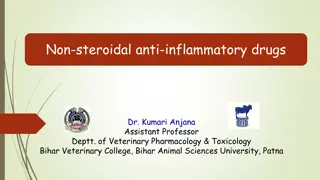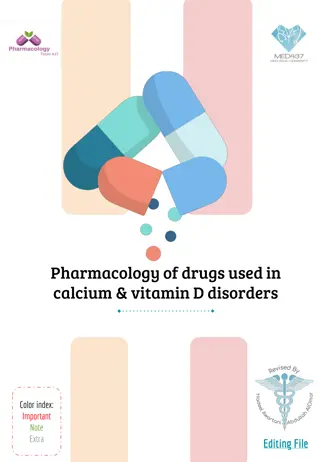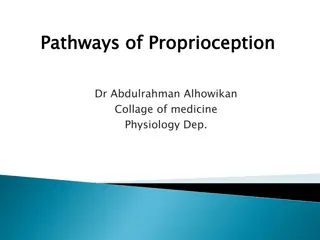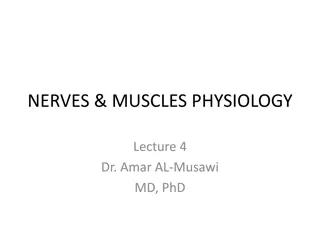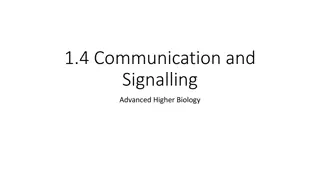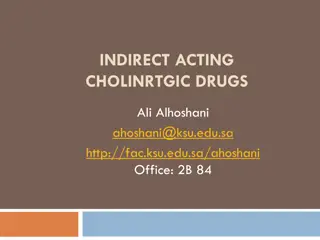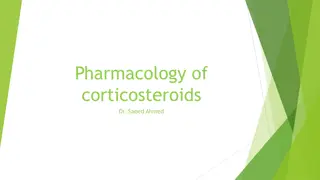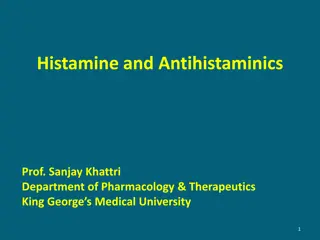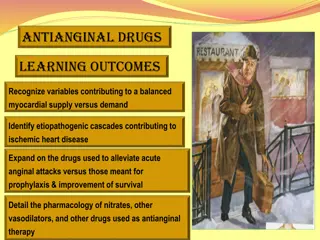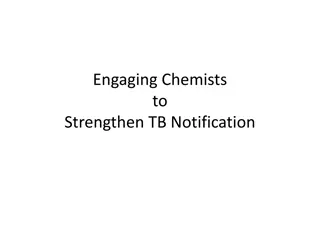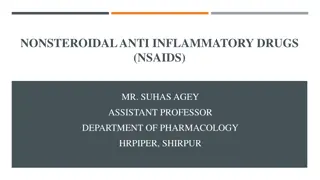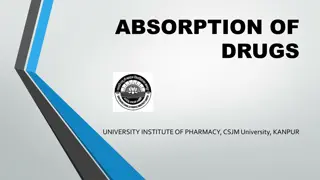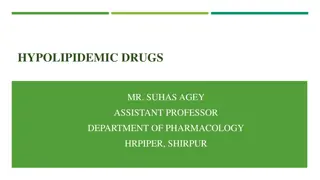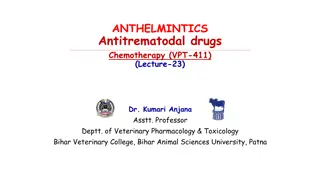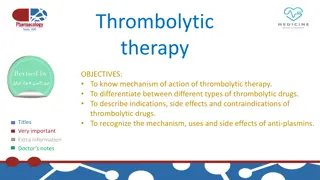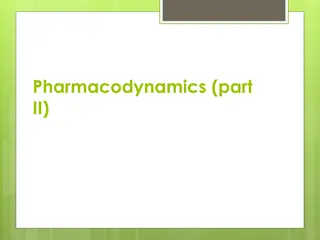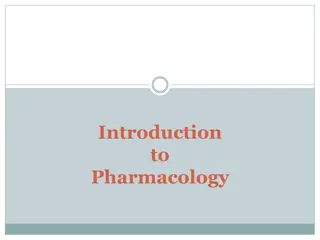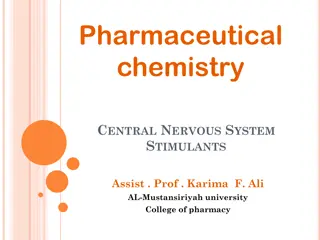Understanding Cholinergic Drugs: Receptors, Actions, and Pharmacology
Learn about the types, locations, and actions of cholinergic receptors, the mechanism of action of direct-acting cholinomimetics, pharmacokinetics of cholinergic drugs, and the pharmacological actions and uses of cholinomimetics. Explore the roles of nicotinic and muscarinic receptors in the nervous system and understand the importance of cholinergic fibers in neurotransmission. Discover the classification and site of action of cholinomimetic drugs, including direct and indirect cholinergic agents.
Download Presentation

Please find below an Image/Link to download the presentation.
The content on the website is provided AS IS for your information and personal use only. It may not be sold, licensed, or shared on other websites without obtaining consent from the author. Download presentation by click this link. If you encounter any issues during the download, it is possible that the publisher has removed the file from their server.
E N D
Presentation Transcript
Editing File Editing File Direct Cholinergic Drugs Objectives: Mention the different types, locations and actions of cholinergic receptors. Identify the mechanism of action of direct acting cholinomimetics. Describe the pharmacokinetics of cholinergic drugs. Identify pharmacological actions and uses of cholinomimetics. Important Notes Extra
Nervous System Central Nervous System Peripheral NS Brain Spinal Cord Afferent (Sensory) Efferent (Motor): Somatic; skeletal muscles Autonomic; Smooth muscles: Sympathetic Parasympathetic Enteric Autonomic PNS Parasympathetic (Cholinergic) Sympathetic (Adrenergic) Enteric (For GIT) It is subdivided into: Parasympathetic our drugs will act here Preganglionic neurons: Long. Synapses with postganglionic at or near organ. Acetylcholine is neurotransmitter. Nicotinic receptor on postganglionic. Postganglionic neurons: Short. Synapses on the organ. Acetylcholine is neurotransmitter. Muscarinic receptor on the organ. *Cholinergic Fibers: Fibers release Ach in ANS. Cholinergic Transmission Half-life of Ach is very short. Targets for pharmacologic therapy (interventions): 1.Synthesis. 2.Storage. 3.Release. 4.Termination of action of the transmitter. 5.Receptor.
Cholinomimetics Drugs that produce actions similar to stimulation of parasympathetic system or similar to Acetylcholine. M.O.A Class Direct Cholinomimetics Indirect Cholinomimetics Cause direct stimulation of cholinergic receptors. Each receptor will give different effect. Acts indirectly by inhibiting Acetyl cholinesterase thus prevent the hydrolysis of Ach. They are called Cholinesterase inhibitors or anticholinesterases Action Cholinergic drugs act upon two types of receptors: Nicotinic receptors Muscarinic receptors Site of Action Cholinergic or Parasympathetic receptors Nicotinic receptors (N) Central Receptors Muscarinic receptors (M) Peripheral Receptors Type II receptors: G-protein linked receptors Located at: All target organs that are innervated by parasympathetic fibers (Heart, CVS, Eye, Bladder, etc). Internal organs except ventricles Subclasses: M1,M3,M5 are excitatory or stimulatory in function. Smooth muscles and glands M2,M4 are inhibitory in function.Heart Stimulated by: Muscarine Type I receptors: Ion channel linked receptors (Na channels) Located in: Skeletal muscles (Neuromuscular junction) (Nm) Autonomic ganglia (Sympathetic and parasympathetic ganglia) (Nn) Adrenal Medulla(Nn) CNS(Nn) Subclasses: Nm: On muscles Nn: On nerves Stimulated by: Nicotine
Nicotinic Receptors VS Muscarinic: Nicotinic receptors Central cholinoceptors Muscarinic receptors Peripheral cholinoceptors Almost excitatory Excitatory or inhibitory Autonomic ganglia Nn sympathetic & parasympathetic stimulation On all peripheral organs innervated by postganglionic parasympathetic fibers Adrenal medulla Nn release of catecholamines (adrenaline & noradrenaline) Heart (bradycardia, M2) exocrine glands (secretion, M3) Smooth muscles (contraction, M3) (GIT, urinary tract, bronchial muscles, uterus) Skeletal muscles Nm contraction Direct Acting Cholinergic drugs: EDRF stands for Endothelium Derived Relaxing Factor Pharmacological actions Actions that are similar to the effects of parasympathetic system activation. And are classified according to the type of receptor acting on into: Actions means uses! Nicotinic Actions Muscarinic Actions Drugs produce their effect on nicotinic receptors Drugs produce their effect on Muscarinic receptors
Cont. Nicotinic actions Muscarinic Actions Contraction of circular muscle of iris (miosis) Contraction of ciliary muscles for near vision Decrease in intraocular pressure (IOP) Low concentration (Therapeutic dose) of Nicotine: Muscle Contraction High concentration (Toxic dose) of Nicotine: Persistent depolarization and relaxation (Blocking of depolarization). Constant contraction of muscle means there is no repolarization which is essential for muscle relaxation leading to muscle paralysis. Succinylcholine has similar effect. Eye (M3) Skeletal Muscles m (M2) Bradycardia (decrease in heart Release of Nitric oxide(NO) (EDRF) Affects blood vessels endotheliu Heart rate) Constriction of bronchial smooth muscles and increase bronchial secretion Lung (M3) Increase in motility(peristalsis) Increase in secretion Relaxation of sphincter causes defecation No with diarrhea GIT (M3) Autonomic By stimulating it. This happens by both sympathetic and parasympathetic stimulation. Secretion of Neurotransmitters Postsurgical Ganglia Bladder Urinary (M3) Contraction of muscles Relaxation of sphincter causes urination By stimulation which leads to the release of Catecholamine (Adrenaline and Noradrenaline). Over stimulation leads Adrenergic crisis Adrenal Gland glands (M3) Increase in exocrine glands secretions which are: Sweat, Saliva, Lacrimal, Bronchial, intestinal glands Exocrine Parasympathetic actions on Eye It innervates the constrictor pupillae (Circular muscle of iris) which is important adjusting the pupil in response to change in light intensity and regulating the intraocular pressure Aqueous humour secreted by ciliary body is removed continuously by drainage into the canal of Schlemm Normal ocular pressure is 10-15 mmHg above atmospheric pressure. Abnormal raised pressure (Glaucoma) leads to retinal detachment Miosis decreases the IOP in Glaucoma by increasing the filtration angle through ciliary muscles contraction When the ciliary muscle contracts, the lens bulge more and this parasympathetic reflex is essential to accommodate for near vision
Cont. Type of Drug Natural Alkaloids Synthetic Choline Esters Alkaloids are lipid soluble nitrogen non polar compound found in nature Tertiary amines Common suffix (ine) which means natural and base Polar (contains N ion) Quaternary ammonium compounds that change the acidity of the medium it acts on -methyl group :Selectivity to M receptor Features Acetylcholine found in our body naturally Carbachol Bethanechol Cevimeline Examples Pilocarpine Nicotine Muscarine Poor distribution Can not cross BBB so no CNS effects Not metabolized by Cholinesterase Have longer duration of action than Ach Never given I.V. or I.M. BUT S.C. why? Because it may cause Cardiac arrest but if you have to inject it that way then do it slowly Why? Non polar, lipid soluble Well absorbed except Muscarine, Excreted by the kidneys. P.K Bronchial asthma Peptic ulcer Angina pectoris Urinary incontinence (increases urination) Intestinal obstruction (it ll increase motility which will lead to perforation with this obstruction) Contraindications of cholinomimetics ) ( (M3) Direct
Natural Alkaloids: Drug Pilocarpine It is not a derivative of Ach M.O.A Direct muscarinic agonist Acts mainly on eye and secretion Nonpolar (Lipophilic) tertiary amine Well absorbed and good distribution Cross BBB so it has CNS effects Cross placenta Not metabolized by Cholinesterase Long duration of action Excretion is enhanced by acidification of urine P.K Xerostomia (Dry mouth) Drug of choice in emergency Glaucoma (applied as eye drops) Local effect Uses Profuse sweating Salivation but it is desirable in dry mouth Bronchoconstriction NEVER given to patients with asthma Diarrhea CNS effects due to its solubility and this raises ADRs ADRs Synthetic Choline Esters: Drug Acetylcholine M.O.A Muscarinic and Nicotinic agonist Not used clinically because: Is not selective as it acts on both nicotinic and muscarinic receptors Has short duration of action. Why? Due to rapid metabolism by acetylcholinesterase Uses
Cont. Bethanechol (Carbamoyl- - methylcholine) Carbachol (Carbamoylcholine) Drug Cevimeline Muscarinic actions on the eyes, GIT, UT. More selective Has nicotinic actions (side effects) First drug in this class Prominent muscarinic actions on GI, UT. No eye No nicotinic actions Direct acting muscarinic agonist (M3) M.O.A Resistant to hydrolysis by acetylcholinestera se Longer duration than Ach Resistant to hydrolysis by acetylcholinesterase Longer duration than Ach P.K - Treatment of Glaucoma as an eye drops only Decreased motility of GI Decreased urination (But not anymore is used for the last two problems) Drug of choice in: Paralytic (Relaxation) ileus Urinary retention in case of post- operative atony (No contraction) and bladder Dry mouth symptom associated with Sjogren s syndrome Uses Nicotinic side effects - - ADRs Sjogren s Syndrome: Autoimmune disease characterized by Formation of antibodies leading to dryness of mouth and eye. Next slide is a summary!
Drug Carbachol Bethanechol Pilocarpine ACh Chemi Quaternary Polar Quaternary Polar Tertiary non polar stry Quaternary Polar Absorp tion NOT better absorbed than Ach Complete metabo metabolized by cholinesterase lism NOT metabolized by cholinesterase Durati on Very short Longer (++) Oral, S.C. Oral, eye drops S.C. administr I.V. Oral, eye drops ation eye drops Drug Carbachol ACh Cevimeline Bethanechol Pilocarpine Recept Muscarinic Nicotinic Muscarinic Nicotinic ors Muscarinic Muscarinic Muscarinic Muscari +++ nic GIT, Urinary bladder More on eye, exocrine glands NO More on eye, exocrine glands Selectivity Eye, GIT Urinary bladder NOT Nico tinic +++ Paralytic ileus Glaucoma Xerostomi a Sjogren's syndrome Glaucoma Uses NO Urinary retention
Questions MCQs: 1-Which of the following is the primary receptor for organs supplied by autonomic system? A. A) Acetylcholine receptors. B) Nicotinic receptors. B. C) Epinephrine. D) Muscarinic. 2-Nicotinic receptors are found in: A) Parasympathetic Ganglia. B) CNS. C) Adrenal Medulla. D) All the above 3-In the ligand-gated ion channel, Ach binds to: A) Alpha subunits. B) Beta subunits. C) Gamma subunits. D) A&B. 4- Which one of the following drugs are used to treat dry mouth symptom that associated with Sjogren's syndrome? A) Carbachol. B) Bethanechol. C) Acetylcholine (Ach). D) Cevimeline. 5-Which one of the following has the shortest duration of action? A) Cevimeline. B) Acetylcholine (Ach). C) Pilocarpine . D) Carbachol. 6-Which one of the following can cross BBB? A) Bethanechol. B) Cevimeline C) Pilocarpine. D) Acetylcholine (Ach). Answers: 1-D 2-D 4-D 3-A 5-B 6-C
Cont.. SAQ: How many acetylcholine bind with ligand-gated ion (N+) channel? 2 acetylcholine molecules What's the function of Adrenal medulla? Release catecholamines ( adrenaline & noradrenaline) Why we don't use Ach clinically? 1. It is not selective as it acts on both nicotinic and muscarinic receptors. 2. It has short duration of action.
It is not hard, you just made it to the end! Team Leaders: Yazeed Alharbi & Aseel Badukhon Thanks for those who worked on this lecture: Abdullah abdurahman al-asseri Abdulhakim Alonaiq Bader Altamimi Fayez Ghiyath Aldarsouni Maan Abdulrahman Shukr Mohammed alnajeim Omar Alsuhaibani Sultan Omar Almalki Yazeed abdullah alkhayyal Ahmed Lateef Alanzy Adel Alorainy References: Team436 Doctors notes and slides @Pharma4370 pharmacology437@gmail.com


